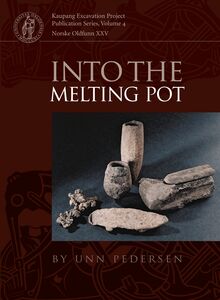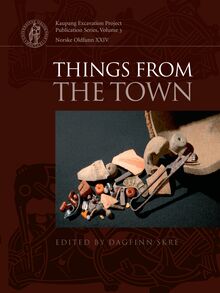Things from the Town , livre ebook
484
pages
English
Ebooks
2011
Obtenez un accès à la bibliothèque pour le consulter en ligne En savoir plus
Découvre YouScribe en t'inscrivant gratuitement
Découvre YouScribe en t'inscrivant gratuitement
484
pages
English
Ebooks
2011
Obtenez un accès à la bibliothèque pour le consulter en ligne En savoir plus
Publié par
Date de parution
01 décembre 2011
Nombre de lectures
2
EAN13
9788771244311
Langue
English
Poids de l'ouvrage
42 Mo
Publié par
Date de parution
01 décembre 2011
Nombre de lectures
2
EAN13
9788771244311
Langue
English
Poids de l'ouvrage
42 Mo
things from the town
Published in the series Norske Oldfunn, Kaupang Excavation Project
Museum of Cultural History, 3 Publication Series, Volume 3
University of Oslo Norske Oldfunn XXIV
The third volume covering the excavations of 1998–2003 in the Viking-period
town of Kaupang examines a range of artefacts and discusses the inhabitants of
the town: their origins, activities and trading connexions. Certain key threads things from
from both this and the two previous volumes in the series are drawn together.
The main categories of artefact are metal jewellery and ornaments,
gemstones, vessel glass, pottery, fnds of soapstone, whetstones and
textile-production equipment. The artefacts are described and dated, and in some cases their the townareas of origin are discussed.
An exceptional wealth and diversity of artefacts distinguishes sites such as
Kaupang from all other types of site in the Viking world. This refects the fact
that a large population of some 400–600 people, engaged in a comprehensive
range of production and trade, lived closely together in the town c. ad 800–930.
The fnds and structural remains make it possible to identify the activities
that took place within the six buildings excavated. The earliest buildings were in
use only periodically, but those erected in the 820s were occupied permanently.
The earlier structures were used for limited periods by a variety of craftsmen,
but those in permanent occupation were primarily houses and only secondarily
workshops.
Throughout the life of the town, trade links with southern Scandinavia, the
Baltic and the Irish Sea appear to have been strong. In the earliest phases of the
town there was considerable trade with the Frisian zone, probably with Dorestad,
but this link faded in the second half of the 9th century, probably because
Dorestad had been abandoned. Kaupang seems to have been supplied with goods
from the interior of eastern Norway, while goods from the western coastland of
Norway are all but absent.
Finds of personal equipment show that many of the inhabitants were from
southern and western Scandinavia. One house can be identifed as that of a
Frisian household engaged in trade. There were also Slavs in Kaupang, although
it is not clear if they too were long-term residents.
Kaupang was located in a border zone between southern and northern
Scandinavia as well as between the East and the West. The trading potential of
such border zones is probably why Kaupang, unlike Ribe, survived the demise of
the Frisian trade in the mid-late 9th century.
E d i t e d b y d a g f i n n s k r e
Aarhus University Pressa
63077_cover_kaupang 3_r2.indd 1 11/2/11 8:25 AMThings from the Town
Artefacts and Inhabitants
in Viking-age Kaupang
This page is protected by copyright and may not be redistributed
63077_kaupang-vol3_.indd 1 05/10/11 21.4963077_kaupang-vol3_.indd 2 05/10/11 21.49Things from the Town
Artefacts and Inhabitants
in Viking-age Kaupang
Edited by Dagfnn Skre
Kaupang Excavation Project
Publication Series, Volume 3
Norske Oldfunn XXIV
This page is protected by copyright and may not be redistributed
63077_kaupang-vol3_.indd 3 05/10/11 21.49Tings from the Town
Artefacts and Inhabitants in Viking-age Kaupang
Kaupang Excavation Project Publication Series, Volume 3
Norske Oldfunn XXIV
© Aarhus University Press & the Kaupang Excavation Project,
University of Oslo 2011
Published as part of the series Norske Oldfunn,
Museum of Cultural History, University of Oslo
English translation and revision: John Hines
Copy editing: Dagfnn Skre
Map production, illustration editing: Julie K. Øhre Askjem,
Anne Engesveen, Elise Naumann, Dagfnn Skre
Cover illustration: Artefacts found at Kaupang. Photo, Eirik I. Johnsen, KHM
Graphic design, typesetting and cover: Jørgen Sparre
Type: Minion and Linotype Syntax
E-bookproduction: Narayana Press, Denmark
ISBN 978-87-7124-431-1
Copyright maps:
Contour distance 1 metre: Te Municipality of Larvik
Contour distance 5 metres: Norwegian Mapping and Cadastre Authority,
Permission number NE12000-150408SAS
Scandinavia, Europe: ESRI
The University of Oslo wishes to thank the fnancial contributors to the Kaupang Excavation Project:
Ministry of the Environment The Anders Jahre Humanitarian Foundation
Ministry of Education and Research Vestfold County Council
Ministry of Culture and Church Affairs The Municipality of Larvik
The Research Council of Norway Arts Council Norway
This page is protected by copyright and may not be redistributed
63077_kaupang-vol3_r2.indd 4 25/10/11 11.17Contents
1 Dagfnn Skre
Introduction 13
2 Lars Pilø, Dagfnn Skre
IntroductiontotheSite
2.1 Exploring Kaupang and Skiringssal 1867–1999 17
2.1.1 The cemeteries 17
2.1.2 The settlement 20
2.2 Fieldwork in the Kaupang settlement 1998–2003 20
2.2.1 Research questions 20
2.2.2 Overview 20
Surveys 20
Excavations 21
Method of excavation 22
2.2.3 Context 23
2.3 Main results 1998–2003 26
PartI JewelleryandOrnamentation 27
3 Birgitta Hårdh
ScandinavianMetalwork 29
3.1 Dating Viking-period objects 30
3.2 Changes in distribution maps 35
3.3 Scandinavian jewellery and mounts from Kaupang 35
3.3.1 Brooch with rhomboidal foot 35
3.3.2 Equal-armed brooches 36
Two hachured brooches 38
Two (three) fragments of Ljønes brooches 39
A further fragment 40
Quadruped and knob 40
Summary 42
3.3.3 Trefoil brooches 43
Summary 46
3.3.4 Round brooches 47
3.3.5 Other brooches 50
3.3.6 Pendants 50
3.3.7 Fragments of brooches or pendants 52
3.3.8 Arm- and neckrings 53
3.3.9 Pins 55
3.3.10 Mounts 55
3.3.11 Types not represented amongst the fnds 57
c o n t e n t s 5
This page is protected by copyright and may not be redistributed
63077_kaupang-vol3_.indd 5 05/10/11 21.49
173.4 ThedatingoftheobjectsfromKaupang 58
3.5 Therecyclingofmetal
3.6 Summary 61
4 Egon Wamers
ContinentalandInsularMetalwork 65
4.1 Continentalmetalwork 66
4.1.1 Thefnds fromKaupang1998–2002 66
Sword-belt mount 66
Fragment of a strap-end 69
Two strap-ends 71
Two strap-slides 72
Cross brooch 74
Fragment of an equal-armed brooch 76
Fragment of an equal-armed brooch
Double-ended dress-hook (Agrafe à double crochet) 78
794.1.2 A fnd fromHuseby2000–2001
Mount-fragment 79
4.2 Insularmetalwork 80
4.2.1 Thefnds fromKaupang1998–2002 80
Mount-fragment 80
Mount-fragment 81
Fragment of an annular brooch (pseudo-penannular)
Mount-fragment 83
Mount-fragment 83
Gold appliqué 84
Gold mount 84
Gold fligree appliqué 85
Fragment of gold with fligree 86
Buckle-fragment 87
4.2.2 A fnd fromHuseby2000–2001 88
Belt buckle 88
4.3 Generaldiscussion 88
4.3.1 TheContinentalfnds 90
4.3.2 TheInsularfnds 93
Acknowledgements 97
5 James Graham-Campbell
PinsandPenannularBrooches 99
5.1 Terminalfragmentfromapenannularbrooch 99
5.2 Pinhead-fragmentfromaball-typepenannularbrooch 100
5.3 Theplainloop-headedringedpinfromHuseby 103
5.4 Bonepin-fragmentwithironring 103
5.5 Vestfold-typestick-pin 104
5.6 Fragmentofapintip 104
5.7 Twopolyhedralterminalknobsfrompenannularbrooches 104
Acknowledgements 106
6 t h i n g s f r o m t h e t o w n
This page is protected by copyright and may not be redistributed
63077_kaupang-vol3_.indd 6 05/10/11 21.49
77
59
826 Heid Gjøstein Resi
AmberandJet 107
6.1 Amber
6.1.1 Baltic amber 108
6.1.2 Amber from the excavations of 1950–1974 109
6.1.3 Amber from the excavations of 1998–2003 110
Raw material (N=161) 110
Production waste (N=996) 110
Unfnished beads (N=44) 110
Finished beads (N=52) 111
Pendants and amulets (N=14: 11 unfnished, 3 fnished) 114
Rings (N=2) 116
Gaming-piece (N=1) 116
Inlay (N=1) 117
Objects of unknown function (N=31) 117
Distribution of amber in the settlement area: dating and possible production sites 117
6.1.4 Comparative perspective 118
6.2 Jet and jet-like materials 123
6.2.1 Evidence of the working of jet at Kaupang? 125
6.2.2 Comparative perspective 125
Acknowledgements 127
Appendix 6.1 List of amber fnds 128
7 Unn Plahter
AnalysesofJet-likeObjects 129
7.1 Methods 131
7.2 Results 131
The proportions of organic and inorganic material 131
XRF analyses and the distribution of elements 133
Visual assessment 133
Lump 1964 5h – 5i (2): FTIR and SEM_EDX analyses 133
7.3 Related material 136
7.4 Conclusions 140
Acknowledgements 141
8 Heid Gjøstein Resi
Gemstones:Cornelian,RockCrystal,Amethyst,FluorsparandGarnet 143
8.1 Previous studies of gemstones from Kaupang 146
8.2 The material 146
8.2.1 Cornelian 146
General assessment 148
8.2.2 Rock crystal 149
Rock crystal, quartz and quartzite as possible raw material 152
The manufacture of rock-crystal beads at Kaupang? 152
8.2.3 Amethyst 153
8.2.4 Fluorspar 154
8.2.5 Garnet 154
8.3 Comparative perspective 154
Acknowledgements 157
Appendices 8.1–5: Catalogues 158

